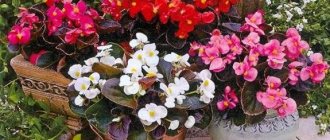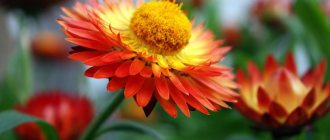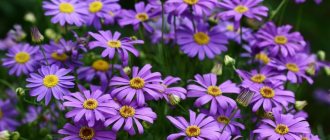Despite the fact that the bell has about four hundred and forty species, there are also some flowers that, from a distance, may be similar in structure to the bell. We have prepared for you a detailed selection of bell-like flowers with photos and basic recommendations for care and propagation. Use, save, share with other gardeners!
Adenophora
Adenophora is a close relative of the bell, which is easy to guess from its popular name - bell.
Using hedgehogs to process potatoes
Types of seedling cassettes and their use
Hazelnut - how it grows and blooms, growing a nut in the garden
This herbaceous perennial is unpretentious, can grow in both sun and partial shade, is undemanding to the type of soil, and does not require shelter for the winter. Keep in mind that adenophora needs good soil drainage and does not grow well in acidic soils.
Bellflower blooms most of the summer. Easily propagated by seeds. In this case, winter sowing is preferable. If you did not have time to sow bells in late autumn and plan to sow in the spring, it is advisable to stratify them for a month (keep them in the refrigerator).
Aquilegia
Behind the beautiful name aquilegia lies a well-known watershed. He is an eagle, doves, boots - there are countless popular names. English-speaking gardeners even call it "granny's hat."
About a hundred species of aquilegia are known, but hybrids are usually grown in gardens. Almost all watersheds feel great in the middle zone and even winter in the taiga zone without shelter. In addition, they prefer partial shade. Why isn't it an ideal plant for the garden?
The height of the plant can vary depending on the species: for example, from 30-40 cm for Biedermeier aquilegia and up to 120 cm for McCann hybrids.
Aquilegia blooms between June and August, depending on the variety. Sowing is carried out in open ground in the fall or through seedlings in March-April or in open ground in May.
Planting a bell in open ground
Do-it-yourself planting work is carried out according to a standard algorithm. If all requirements are met, the crop will delight you with its bright buds throughout the summer season.
Growing bells from seeds
Before planting, preliminary preparation of the seed material is carried out; ordinary paper and a saucer are used for it. The seeds are scattered onto a moistened sheet, which is carefully transferred to a plate filled with water. After the first shoots appear, the young plants are transplanted into prepared soil.
Bluebell seeds
The soil should be loose and light, with good drainage. It is moistened, and the seeds are pressed in a little. After repeated spraying, the boxes are covered with plastic wrap and moved to a warm room.
After 14 days, seedlings will appear, after which it is necessary to remove the covering material. The seedlings are allowed to grow and become stronger, the soil is regularly loosened and watered. If the plantings are too dense, a dive is carried out - when the first two leaves are formed.
Important! The healthiest individuals are carefully transplanted into separate containers.
What you need to plant bluebells
The plant is distinguished by its love for diffused lighting and stable temperature conditions, not lower than 15 degrees. The soil is constantly loosened and irrigated, the green part is sprayed
You need to care for young individuals carefully so as not to accidentally injure the thinnest branches.
Transplantation is carried out in the spring - the plants are removed from the pots along with a lump of earth and transferred to previously prepared holes. The voids are filled with substrate, compacted and watered.
Important! To prevent problems with rooting, it is necessary to regularly remove weeds growing near the crop
How to choose the optimal location
When planting in fresh air, choose a place located away from tall and branchy shrubs and spreading trees that may block the sun. The plant prefers to grow on calcareous and slightly alkaline soils with good drainage.
The distance between the bushes depends on their final size:
- for tall people - not less than 0.5 m;
- for medium-sized children – 0.3 m;
- for miniatures – 10 cm.
Important! When forming an alpine hill, large-sized plants are planted in the background, medium-sized plants are planted in the middle, and the smallest bushes are planted in front. To emphasize the beauty of the crop, it is surrounded by lawn grass
Bells in the open ground
How to feed bells for lush flowering
When planting, do not forget about turf and fertilizers. Peat, manure and bird droppings are prohibited - they are sources of fungal infections. Preventive treatment against diseases and insect pests is carried out using granulated superphosphate.
To obtain the most lush flowering, fertilizers are introduced into the soil:
- primary fertilizing is prescribed for spring - a composition containing nitrogen is purchased for it;
- secondary - after the formation of the first buds, during this period it is better to use complex mixtures.
Important! To increase the number of flowers, it is necessary to promptly get rid of wilted inflorescences. The duration and splendor of flowering depends on following the rules of regular crop renewal: shrubs need to be transplanted to new places
Polite and careful care will allow you to create a flower garden of extraordinary beauty.
Preparing for winter
For one-year and two-year options, no preparatory work is carried out. Long-lived crops require pruning to the lowest points after September 20. Frost-resistant species will easily survive the winter, but heat-loving species need shelter consisting of dry foliage and spruce or pine paws. Tall individuals are additionally covered with a 30 cm layer of humus and peat.
Bluebells are unpretentious plants that can be used to create a bright and memorable landscape design. They will be able to add color to front gardens, flower beds and alpine slides. Artists like to use them as a stencil for coloring books - so it won’t be difficult for a child to draw and name such a flower.
vote
Article Rating
Brugmansia
This plant is often called "angel's trumpets". This is due to the fact that it grows incredibly quickly, and the flowers of this crop can increase by 3-4 cm in 24 hours, and if the growing conditions are more than favorable, then even by 6-7 cm.
Brugmansia is a large and lushly flowering tree-like shrub that reaches 5 m in height. Its flowers are incredibly attractive. These are huge bells, up to 20 cm in diameter and up to 50 cm in length.
The buds of the culture have a persistent characteristic aroma, which is especially intensified at night. The color of the petals can be pink, orange, peach, yellow, cream and even greenish.
Perennial bells
There are many perennial varieties of bells, so they are usually classified by height, dividing them into low-, medium- and tall-growing.
Low-growing species
Carpathian
Carpathian bellflower grows in mountainous areas
One of the most popular varieties among domestic gardeners. Cultivation of the variety began in the Carpathians and mountainous areas of Central Europe. The height of the bushes rarely exceeds 30 cm, the shoots are well leafed and have a basal rosette of long-petioled leaves.
The plant produces single large flowers (about 5 cm in diameter) in the shape of a gramophone. The color can be white, light blue or purple. Flowering is long-lasting: starting in June, it lasts until the end of summer.
Gargansky
The Gargansky bell reaches a height of 10–15 cm
The plant reaches a height of 10–15 cm. It forms branched creeping stems that break easily. The shoots are leafy with rounded, three-toothed leaves. The flowers are blue, star-shaped, and grow up to 4 cm.
spiral-leaved
Campanula Spiralifolia native to the Carpathians
The bush of this variety also does not exceed 15 cm. The plant comes from the Carpathians and is also found in the Alps. The shoots are creeping, with numerous small blue or white flowers. The flowers are drooping, regular bell-shaped.
Shamiso
Bell Shamiso comes from the Far East
This miniature form came to us from the Far East. Forms single flowers, each of which reaches 3 cm in diameter, painted in a pale bluish tint. The corolla is characterized by the presence of a shaggy edge.
Medium height perennials
Takeshima
The Takeshima bell was discovered in Korea
The plant comes from Korea. The bushes are distinguished by a large number of basal rosettes; the shoots grow up to 60 cm in height and can be creeping or drooping. Flowers come in regular or double, white, pink or blue shades. Flowering is lush and begins in June.
Komarova
Komarov's bell produces large flowers of bright purple color
The plant forms powerful branching shoots of medium height - no more than 45 cm. It blooms profusely, forms large flowers of bright purple color. A characteristic feature is pointed, slightly turned away lobes of the petals.
Spot
Campanula dotted with drooping flowers
An original variety, with a large number of basal leaves and thin tall stems - up to 50 cm. The flowers are large, slightly pubescent, drooping, with a regular goblet shape. The pedicels are long and milky white. The surface of the flowers is covered with many purple dots.
Sarastro
Sarastro's bell has large flowers
This is a hybrid form of the previous variety. It has large dark purple drooping flowers on high (up to 60 cm) shoots. The bushes are spreading and voluminous, reaching 40 cm in diameter.
Tall perennials
broadleaf
Broadleaf bellflower grows in coniferous forests
This variety has become widespread in coniferous forests or on the coasts of reservoirs. A shoot with a small number of leaves grows up to 1 m in height, large leaves - up to 12 cm in length. The flowers are large, axillary, funnel-shaped. The color can be white, blue or lilac.
Bluebell Peachleaf
Bluebell Peachleaf begins to bloom in June
The variety was named for the similarity of the leaves to the foliage of a peach tree. Forms tall – from 50 to 10 cm – shoots with large, wide-bell-shaped flowers, collected in paniculate inflorescences. The flowering of the crop begins in June and lasts about 30 days.
Milky-flowered
Campanula lactiflora grows up to 1.5 m in height
Plants of this variety can grow up to 1.5 m in height. The taproot makes it possible to successfully grow the crop even on heavy loamy soils. The inflorescences are collected in clusters of medium-sized milky-white flowers. Blooms in June and blooms until autumn.
Hyacinthoides
Hyacinthoides are bulbous perennials that belong to the early flowering plants. There are other names: “Spanish scilla”, “Spanish endymion”, “Spanish scilla” and “wild hyacinth”.
This is an unpretentious crop that can often be found in flower beds and garden plots. The plant has basal leaves 20-30 cm long and a single peduncle reaching a height of up to 30 cm.
Hyacinth may have lilac, white, pink, blue or blue bell-shaped flowers 1.5-2 cm in diameter. The crop blooms at the end of May or beginning of June, and this period lasts up to 20 days.
Types and varieties
It is believed that bells come in the following types based on their growth:
- annuals;
- perennial.
Bells can be divided into the following types:
- garden;
- field;
- forest;
- mountain
In height they can be as follows:
- short - no more than 10 cm;
- medium – up to 40 cm;
- tall - from 40 cm in height.
Next, we will consider the most current varieties and types.
Nettle-leaved
Nettle-leaved winter-hardy bell is one of the most common species that, perhaps, everyone has seen. It is a perennial, reaches a height of 70 to 100 cm. The stems of the plant are thick and straight, the leaves are large, reminiscent of nettles, the lower ones are located on long petioles. The flowers are located in the axils of the leaves from one to three. The corolla is usually lilac-blue or lilac-lilac; white color is less common.
Round-leaved
We recommend paying attention to another perennial - round-leaved bell. This plant usually reaches a height of no more than 40 cm
The leaves, as the name suggests, are rounded. By the beginning of flowering, they die off, but the stems remain green until the onset of autumn. The flowers are small and can be purple, blue or pale blue. This variety is very popular in the Caucasus and in the central zone of our country.
Spreading
A beautiful wild bellflower, which is often planted by gardeners, is a spreading species. It is a biennial and can reach 50–60 cm in height. The flowers have elongated pedicels, which are collected in paniculate inflorescences.
Peach-leaved
Peach-leaved bells are also popular in Russia. Their height can vary from 40 to 150 cm depending on the place of growth. Flowers can be purple, lilac, blue and white. They are located on short stalks, which makes the plant very sophisticated. The most relevant varieties include the following:
"Alba" has white flowers; height – approximately 80–90 cm;
Compact
Among the compact species, you can take a closer look at the Carpathian perennial bell, which does not exceed 10–15 cm in height. It gets along well in a flowerbed with other flowers. The color ranges from light blue to white, the flowers are very delicate, the leaves are oval, slightly pointed.
Crowded or prefabricated
This variety is a perennial. The height of the plant reaches 30–60 cm. The flowers are usually light purple, less often pale white. Popular varieties include the following:
- “Gnome” - this variety has deep purple funnel-shaped flowers and matte green leaves;
- "Alba" - white flowers with short pedicels;
- “Carolina” - light pink flowers of an original shape can become a real decoration of the garden;
- “Blue” - the flowers have a rich blue color.
Field varieties also include the Bolognese bell and the small one. The “Bride and Groom” hanging bells, which can be planted in flowerpots, are in demand among gardeners. You can also find the name “room bell”. Such plants in pots are often sold ready-made by professional flower growers.
Of course, these are not all varieties and varieties that can be grown in garden conditions without much difficulty.
Gentian
Gentian has not yet taken root among our gardeners as a popular flowerbed decoration. It is quite rare to find it in a modern front garden. However, this plant is undeservedly underrated. This is a low to medium-height herbaceous plant with large flowers located very close to each other, thus creating a blooming cloud. The gentian plant came to us from the wild. It is great for decorating flower beds, edging flower arrangements, and also for decorating borders. This flower has collected the widest palette of blue shades. No other plant can boast such an abundance of blue, blue and purple flowers. There are about 90 varieties of gentian, among which there are other shades, for example, white, pink and yellow. Gentian has a long flowering period, which begins in summer and ends in late autumn. It is quite common in different latitudes of Europe and Asia.
How to water Decembrist at home?
How to replant aloe at home step by step
How to replant anthurium at home video
A plant such as gentian is propagated by dividing the bush, cuttings or sowing seeds. Planting and caring for seedlings require attention. Growing gentian from seeds is difficult because the seeds are very small and their development requires moist, well-ventilated conditions with a temperature of 7 degrees Celsius. They germinate only after 1-3 months. If the temperature rises significantly during this period, the seedlings may die.
Datura
Datura common (photo below) is difficult to confuse with other plants. He is big, even huge. The bush can grow up to a meter in height. The leaves are beautifully cut. They look powerful, fresh, attractive (for those who eat grass). Only animals will not feast on them. They are repelled by a strange, even disgusting smell. Datura plant can be found in large quantities in any area. Typically, Datura chooses the following areas for its habitat: wastelands, roadsides and vegetable gardens. Datura grass flowers are so magnificent that this plant has attracted the attention of landscape designers. It can be seen in flower beds and lawns. The plant is used as an ornamental. Moreover, it has a fairly long flowering period: almost all summer (depending on climatic conditions) it delights viewers with huge bowls of white flowers. You just need to keep in mind that the plant is poisonous. Flowers can be intoxicating (hence the name) with just their scent. In hot weather, in the absence of wind, it concentrates around the plant. It is not advisable to plant such “decor” in the area near children’s playgrounds, institutions, cafes, and so on. Kids may not realize that they should run away from a cloying aroma. The result is a hospital.
Planting bells in open ground
At what time are seedlings planted in the ground?
As a rule, grown bells can be planted in open soil either in the last days of May or in the first days of June. Most species of such flowers belong to light-loving plants. There are also shade-loving species, but extremely rarely; they stand out for their dark green foliage. This plant does not tolerate drafts.
You need to choose soil depending on the type. Thus, some grow well on calcareous soil, while others grow well on rocky soil. But most species grow best in neutral or slightly alkaline loamy soil that is well drained. Before planting, the soil must be prepared. When digging deep into heavy soil, you must add humus or sand. If the soil is poor, then turf soil and fertilizers must be added to it. However, the use of peat and fresh manure is not recommended, as this can cause the development of a fungal disease.
Rules for planting seedlings in the ground
For planting, you should choose an open place; there should be no bushes or trees growing next to it. In this case, the root system will receive a sufficient amount of nutrients and water. The distance between the bushes depends on the type of bells. Thus, 40–50 centimeters should be left between tall species, 20–30 centimeters between medium-sized species, and 10 to 15 centimeters between short-growing species. When the plants are planted, the soil around them should be thoroughly compacted, and then watered.
Lobelia
From June to September, lobelia pleases us with its flowering. Planting and care are not difficult. Photos taken in summer cottage gardens show that this delicate flower will look appropriate wherever you plant it. Lobelia flower fireworks have a different range of shades: white, red, burgundy, purple, blue, light blue. It is used to design flower beds, garden paths, borders, mixborders, flower “streams” or rugs.
Lobelia belongs to the bellflower family and is a creeping plant. The bushes are distinguished by abundant flowering, since small fan-shaped flowers bloom almost simultaneously, their number is huge.
The most common varieties of lobelia begin to bloom approximately 70-80 days after sowing the seeds. If you want to time the appearance of flowers just in time for the beginning of summer, then you need to start sowing seedlings in March. In general, these dates are not critical; they can be slightly shifted either towards February or closer to April. If sowing will be done at the end of February, then you will not be able to do without the help of lighting (fluorescent, halogen, LED lamps). Germination of lobelia sprouts can be observed already on the tenth or twelfth day after sowing.
Bluebells amaze with their large number of varieties with which you can decorate your garden. And at the same time, it requires absolutely no complicated care.











